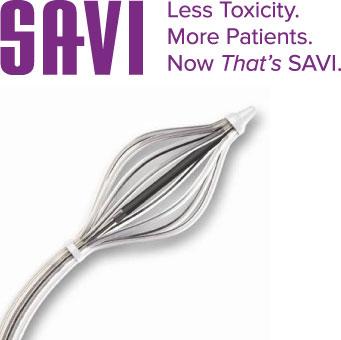
September 17, 2014 — Cianna Medical Inc. announced five-year results for the first 200 hundred patients treated with the SAVI breast brachytherapy applicator, including excellent local control, low rates of toxicities and excellent cosmetic results. An additional study of nearly 600 patients with over three years of follow-up reported similar outcomes, leading researchers to conclude that strut-based brachytherapy is a “well-tolerated, effective treatment” for many women with early-stage breast cancer.
SAVI is a strut-based applicator that delivers a form of accelerated partial breast irradiation (APBI) known as breast brachytherapy, a five-day course of targeted radiation for early-stage breast cancer. Data came from the SAVI Collaborative Research Group, which studies the long-term outcomes of women treated with strut-based brachytherapy, and was presented at the 56th annual meeting of the American Society for Radiation Oncology (ASTRO), Sept. 14-17, 2014.
The five-year data is the most mature follow-up of the largest cohort of patients treated with strut-based brachytherapy to date. The ipsilateral breast tumor recurrence rate (IBTR) was 3.0%, and late toxicity rates were low, including telangiectasisas (1.6%), seroma (3.2%) and fat necrosis (0.5%). Good/excellent cosmesis was seen in more than 93% of patients at all times of follow-up.
“Over the years, our data have continually shown strut-based brachytherapy to be a safe and effective treatment for lower risk breast cancers. With five years of follow-up, this study confirms that it can be offered as an option to any APBI-eligible patient,” said lead author Catheryn Yashar, M.D., a radiation oncologist at UC San Diego’s Moores Cancer Center, La Jolla, Calif., and co-principal investigator of the SCRG. “In addition to excellent local control, the low toxicities and great cosmetic outcomes clearly demonstrate the benefits of a highly targeted treatment that reduces unnecessary radiation exposure to healthy tissue and critical structures.”
A second study of an even larger patient population demonstrates similarly favorable outcomes with strut-based brachytherapy. Out of 596 patients with 39-months median follow up, the study authors report excellent local control (IBTR = 2.8%), good/excellent cosmesis in over 94% of patients, and low rates of toxicities (telangiactasias — 1.0%; seroma — 3.0%; fat necrosis — 0.8%).
A third, single-institution study also presented at ASTRO compared the dosimetric capabilities of the SAVI applicator to balloon-based brachytherapy catheters. In a retrospective analysis of 535 patients, researchers concluded the dosimetric flexibility of the strut-based device was more effective than balloon-based devices in minimizing unnecessary radiation to the skin and ribs while maintaining effective tumor control.
“The goal of breast brachytherapy is to intensify treatment to the area most at risk for recurrence, targeting just the affected part of the breast in order to achieve effective tumor control while reducing toxicity and achieving better cosmetic outcomes,” said study author and radiation oncologist Robert Hong, M.D., Virginia Hospital Center, Arlington, Va. “Our study demonstrates that while all breast brachytherapy catheters are capable of achieving this goal relative to whole breast irradiation, the unique strut-based design of the SAVI applicator makes it significantly more effective in minimizing dose to normal tissue without compromising coverage of the target tissue.”
Strut-based brachytherapy is used as part of breast conservation therapy (BCT), which consists of a lumpectomy followed by radiation therapy. Whole breast irradiation (WBI) radiates the entire breast, including healthy tissue and underlying structures, while breast brachytherapy delivers targeted radiation to the area immediately surrounding the lumpectomy cavity. The clinical benefits of targeted radiation like brachytherapy include reduced radiation exposure to healthy tissue, better cosmetic results, fewer long-term side effects, and preserving more treatment options in the future in the event of a recurrence or new primary cancer.
Patient eligibility for breast brachytherapy includes lower risk cancers, as well as a number of other factors, including tumor size, age, margin status and lymph node involvement. The strut-based, open architecture design of SAVI allows physicians to sculpt radiation based on patient-specific anatomy, which may increase the number of women eligible for breast brachytherapy.
For more information: www.ciannamedical.com


 December 11, 2025
December 11, 2025 








